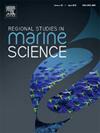Elemental accumulation in loons wintering along the Korean coast: Focus on vanadium and other toxic heavy metals
IF 2.1
4区 环境科学与生态学
Q3 ECOLOGY
引用次数: 0
Abstract
Three of the five global loon species commonly winter along the Korean coast, where they have increasingly been found dead or moribund. This study investigated hepatic elemental concentrations in 86 Arctic Loon (Gavia arctica), Pacific Loon (G. pacifica), and Red-throated Loon (G. stellata) carcasses collected from Korean coastal areas between 2010 and 2017 to assess the potential ecological impacts of elemental exposure. We analyzed 11 elements, focusing on toxic heavy metals and vanadium (V), which is a potential biomarker for hydrocarbon contamination. Hepatic concentrations of 10 elements showed no significant differences among causes of death, species, or geographic locations. Uranium was not detected in any samples. Notably, V accumulation patterns aligned with previous findings on polycyclic aromatic hydrocarbons (PAHs) in these birds, and weak, but significant correlation was observed between ∑16PAHs and V. This suggests that V from marine oil pollution may contribute to its accumulation in loons. The study found elevated levels of mercury and cadmium in all three loon species, but lead levels were not concerning. Temporal trend analysis over eight years showed no clear patterns in any examined element. Given the extensive breeding and migration routes of loons across Northeast Asia, North America, and Russia, this research underscores the importance of continuous ecotoxicological studies to address potential risks of environmental contamination for these migratory birds. Our findings contribute to understanding elemental exposure in wintering loons along the Korean coast and highlight the need for continued monitoring and international collaboration in migratory bird conservation efforts.
求助全文
约1分钟内获得全文
求助全文
来源期刊

Regional Studies in Marine Science
Agricultural and Biological Sciences-Ecology, Evolution, Behavior and Systematics
CiteScore
3.90
自引率
4.80%
发文量
336
审稿时长
69 days
期刊介绍:
REGIONAL STUDIES IN MARINE SCIENCE will publish scientifically sound papers on regional aspects of maritime and marine resources in estuaries, coastal zones, continental shelf, the seas and oceans.
 求助内容:
求助内容: 应助结果提醒方式:
应助结果提醒方式:


